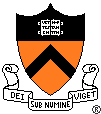

Princeton University |
Computer Science 111 |
|
Principles of Computer Science by Cullen Schaffer
An Invitation to Computer Science by G. Michael Schneider and
Judith L. Gersting.
These texts have been used as the primary text in COS 111 in the past. They
are also overviews of computer science, but each with its own, somewhat
different emphasis from the text by Brookshear. Some students may find these
helpful for alternative explanations of material.
The New Turing Omnibus, by A. K. Dewdney.
The Dewdney book is a
collection of short, mostly self-contained chapters covering a large number of
discrete topics in computer science. Many of the topics we cover in this
course are discussed, often at a level of mathematical sophistication or
background well beyond the level of this course. It is intended for student
enrichment.
Java How to Program by H. M. Deitel and P. J. Deitel.
This is a
serious text on programming with Java. It is well beyond the level of
discussion in this course. It is provided for the student who wants to do
some in-depth exploration of programming.
This course will be essentially ``paperless''. After the second week, all assignments will be posted only on the course Web site. (See details below.) ``Hand-outs'' will be posted on the course Web site as well. Important announcements on all aspects of the course will be made on the ``What's new'' page (accessible from the course home page.) Students are responsible for monitoring the postings under ``What's new''. Schedule changes will be made on the on-line schedule page. and announced under ``What's new''. The only paper we will exchange is your solutions to the problem sets, which we will grade and hand back.
You are encouraged to use electronic mail to set up appointments, leave messages, and ask quick questions (like ``What was that reference you gave today in class?'' or ``I've been at McCosh Infirmary all week, what do I do to make up my lab?'') However, old fashioned face-to-face talking is still best for clarifying confusions and other technical discussions.
There will be nine hands-on computing laboratory exercises to be done during a scheduled laboratory period. Labs begin Monday, September 25, 2000. Students will use Intel PCs with Windows NT. The labs are designed to be easily completable in less than three hours during the scheduled lab sections. Assistants will be in the labs to help out. Most labs require about one hour of preparatory reading. Students obtain the lab assignments from the course Web site, accessible from the course schedule page. Printed copies of only the first lab assignment will be distributed. To receive credit, students must complete labs in the week they are assigned, unless there are extraordinary circumstances and/or prior arrangements. Students must complete all 9 labs to pass the course.
All lab sections take place in room E-203 of the Engineering Quadrangle.COS111 and COS109 will share lab space, but not lab sections. Until we know the relative enrollments, we will not be sure which lab times will be used by which course. The pool of labs times for both courses is:
Instructions for signing up for labs will be given here and in class once the section times for COS111 have been determined.
The lowest problem set grade will be dropped; therefore, students may
choose to skip one problem set.
Students must complete all 9 labs to pass the course.